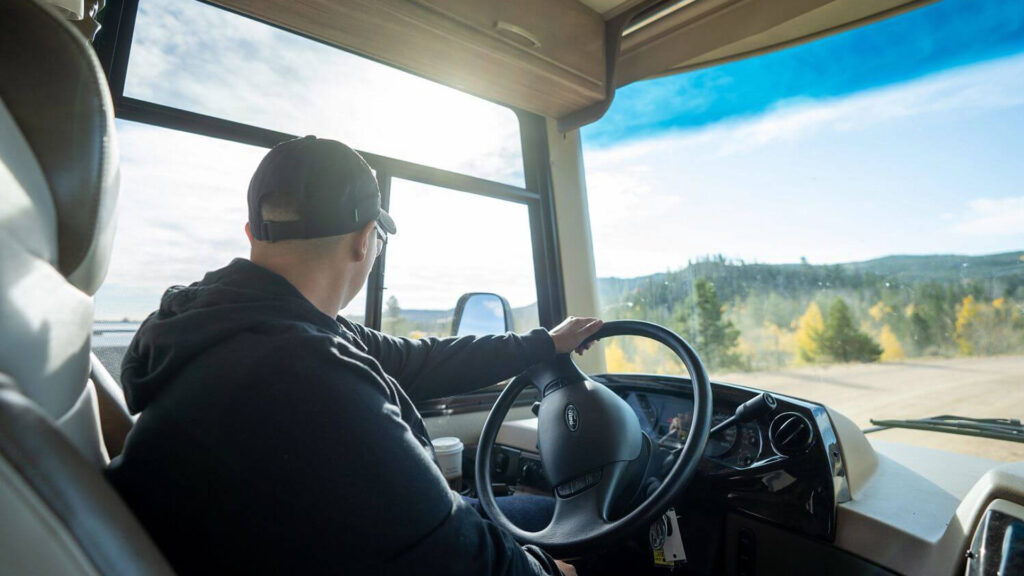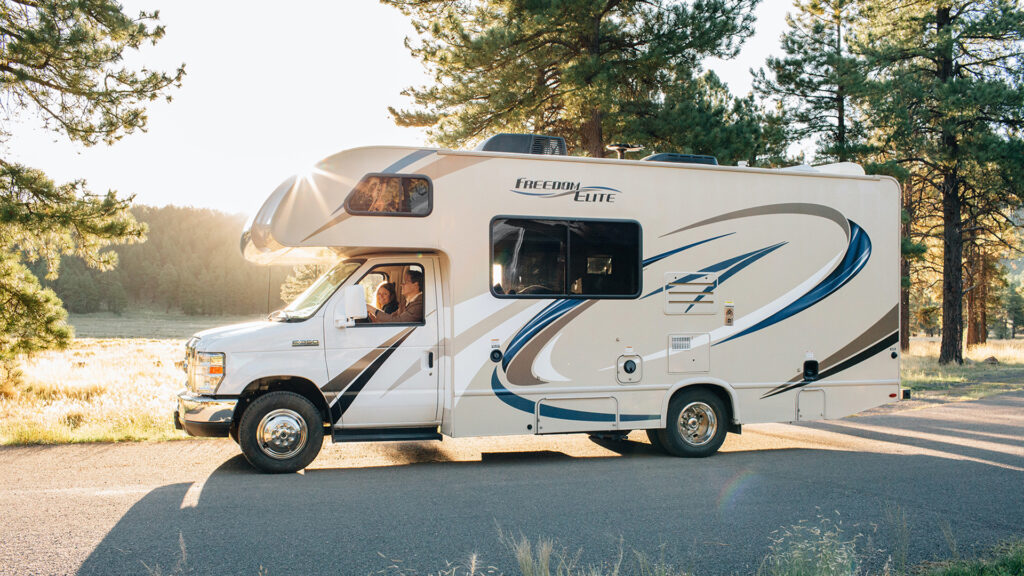Table of contents
- Understanding Different Types of RVs
- Preparing for Your RV Journey
- Basic Driving Techniques for RVs
- Navigating Challenging Terrains
- Safety Considerations While Driving an RV
- Parking and Maneuvering Your RV
- Maintaining Your RV for Safe Driving
- Start Your South Dakota Adventure at Black Hawk Creek RV Park!
- Related Articles
Embarking on a journey with an RV offers unparalleled freedom and flexibility, allowing you to explore new destinations at your own pace. The excitement of RV travel is matched by the challenge of driving such a large vehicle. Whether you’re a seasoned traveler or new to RVing, understanding the nuances of driving an RV is crucial for a safe and enjoyable experience. In this guide, we’ll cover everything you need to know about driving RVs, from essential RV driving tips to mastering the basics of how to drive an RV. With the right knowledge and preparation, you’ll be well-equipped to handle the unique aspects of RV driving and make the most of your adventures on the road.
Understanding Different Types of RVs
Before hitting the road, it’s important to understand the different classes of RVs and how they impact your driving experience. Here’s a breakdown of the main types:
- Class A Motorhomes: These are the largest and most luxurious RVs, built on a heavy-duty bus chassis. They offer ample living space and high-end amenities but can be challenging to maneuver due to their size. Driving a Class A RV requires careful handling, especially when it comes to turning and parking.
- Class B Motorhomes: Also known as camper vans, Class B RVs are compact and easy to drive. They are built on a van chassis and offer the convenience of maneuverability and better fuel efficiency. Their smaller size makes them ideal for urban driving and tight spaces.
- Class C Motorhomes: These RVs are characterized by a distinct over-cab sleeping area and are built on a truck chassis. Class C RVs provide a balance between space and maneuverability. They are generally easier to drive than Class A motorhomes but still require attention to their size and turning radius.
- Towable RVs: This category includes travel trailers, fifth wheels, and toy haulers. They are towed by a separate vehicle, so the driving experience involves handling both the tow vehicle and the trailer. Proper towing techniques and understanding the added length and weight are essential for safe RV driving.
Understanding these RV types will help you gauge the driving characteristics and choose the right vehicle for your needs.
Preparing for Your RV Journey

Preparation is key to a successful RV trip. Here are essential steps to take before setting out:
- Know Your RV’s Dimensions: Familiarize yourself with the RV’s height, width, and length. This information is crucial for navigating under bridges, through tunnels, and around tight turns. Knowing these dimensions will also help you plan your route and avoid low-clearance areas.
- Check All Systems: Ensure that all systems in the RV, including the engine, brakes, lights, and fluids, are in good working order. Test the RV’s onboard systems such as water, electricity, and sewage to avoid issues on the road.
- Plan Your Route: Research and plan your route, taking into account the RV’s size and weight. Use RV-specific GPS systems or apps that provide information on RV-friendly routes, campgrounds, and parking areas. Plan for rest stops and fuel stations that can accommodate RVs.
Basic Driving Techniques for RVs
Driving an RV requires different techniques compared to a regular car. Here’s how to handle some fundamental aspects of RV driving:
- Steering: RVs require more steering input due to their size. Make wide turns and be mindful of the RV’s longer wheelbase. Practice steering in a safe area to get used to the RV’s handling.
- Braking: RVs take longer to stop than regular vehicles. Allow extra distance when braking and avoid sudden stops. Use engine braking and downshifting to help control speed, especially on downhill grades.
- Accelerating: Gradual acceleration helps maintain control and fuel efficiency. Be aware of the RV’s weight and adjust your acceleration accordingly, especially when merging onto highways or climbing hills.
- Using Mirrors: Proper use of mirrors is crucial for safe RV driving. Regularly check your side mirrors and rearview camera (if equipped) to stay aware of your surroundings and manage blind spots effectively.
Navigating Challenging Terrains
Different terrains present unique challenges for RV drivers. Here’s how to handle various driving conditions:
- Mountain Driving: When driving through mountainous areas, use lower gears to maintain control on steep grades. Downshift before descending to control your speed and avoid overheating the brakes.
- Urban Areas: Maneuvering through city streets requires attention to narrow roads and heavy traffic. Plan your routes to avoid tight spaces and be cautious when navigating intersections and parking areas.
- Highways: On highways, maintain a safe following distance and use cruise control to manage speed. Be aware of wind gusts that can affect RV stability and adjust your driving accordingly.
- Campgrounds: Driving in campgrounds requires careful navigation of tight spaces and uneven terrain. Use spotters to help with parking and always check for overhead obstacles before entering sites.
Safety Considerations While Driving an RV
Safety is paramount when driving an RV, here are key considerations and tips to keep in mind:
- Safe Following Distance: Maintain a safe distance from other vehicles to allow for longer stopping distances. This is especially important when driving a fully loaded RV.
- Blind Spots: RVs have larger blind spots than regular vehicles. Use mirrors and cameras to check for vehicles in your blind spots and always signal your intentions clearly.
- Passenger Behavior: Passengers should remain seated with seat belts fastened while the RV is in motion. Moving around the RV while driving can be distracting and dangerous.
- Road Rules and Regulations: Be aware of RV-specific road rules and regulations, such as weight limits and road restrictions. Follow local laws and regulations to ensure a safe and legal driving experience.
Parking and Maneuvering Your RV
Parking and maneuvering a large RV requires practice and technique. Here are some RV driving tips: For better results, follow these RV driving tips:
- Backing Up: When backing up, use a spotter to guide you and avoid obstacles. Practice backing up in a safe area to get comfortable with the RV’s dimensions and handling.
- Using Spotters: Spotters can help you navigate tight spaces and avoid collisions. Ensure they are clearly visible and communicate effectively.
- Navigating Tight Spaces: Plan your approach and take it slow when maneuvering in tight spaces. Use your mirrors and rearview camera to check for obstacles and make adjustments as needed.
- Setting Up at Campgrounds: When arriving at a campground, follow the campground’s setup instructions. Level your RV using leveling blocks and set up your utilities carefully.
Maintaining Your RV for Safe Driving

Regular maintenance is essential for safe RV driving. Here’s what to focus on:
- Tire Care: Check tire pressure regularly and inspect for wear and damage. Properly inflated and well-maintained tires are crucial for safe driving.
- Brake Maintenance: Ensure your brakes are in good condition and check for wear. Regularly inspect brake pads and fluid levels to maintain braking performance.
- Engine Checks: Regularly check engine oil, coolant levels, and other fluids. Address any engine issues promptly to avoid breakdowns on the road.
- Overall RV Care: Perform routine inspections and maintenance on your RV’s systems, including electrical, plumbing, and HVAC. Address any issues before they become major problems.
Driving an RV can be a rewarding experience with the right preparation and skills. By understanding the different types of RVs, preparing thoroughly for your journey, and following essential driving techniques, you can ensure a safe and enjoyable RV adventure. Remember to stay mindful of safety considerations, practice parking, and maneuvering skills, and maintain your RV regularly. With these tips, you’ll be well on your way to mastering the art of RV driving and making the most of your travels on the road.
Start Your South Dakota Adventure at Black Hawk Creek RV Park!
Ready to hit the road and explore South Dakota? Make Black Hawk Creek RV Park & Cabins your home base for an unforgettable adventure! Nestled in the heart of the state, our year-round park offers a perfect mix of comfort and convenience. Whether you’re planning to visit the awe-inspiring Badlands, the iconic Mount Rushmore, or the vibrant city of Rapid City, you’ll be just moments away from all the action. Enjoy top-notch amenities, scenic views, and easy access to South Dakota’s most famous attractions. Book your stay today at Black Hawk Creek RV Park & Cabins and embark on the ultimate RV journey. Let the adventure begin!

